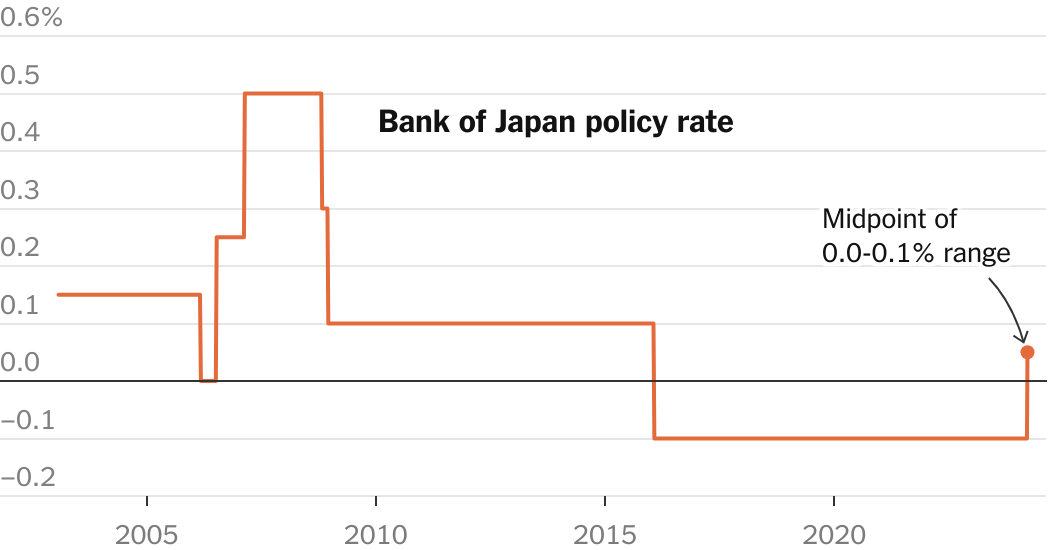Japan’s central bank raised interest rates for the first time since 2007 on Tuesday, pushing them above zero to close a chapter in its aggressive effort to stimulate an economy that has long struggled to grow.
In 2016, the Bank of Japan took the unorthodox step of bringing borrowing costs below zero, a bid to kick-start borrowing and lending and spur the country’s stagnating economy. Negative interest rates — which central banks in some European economies have also applied — mean depositors pay to leave their money with a bank and borrowers can take out loans very cheaply, an incentive for them to spend.
But Japan’s economy has recently begun to show signs of stronger growth: Inflation, after being low for years, has sped up, cemented by larger-than-usual increases in wages. Both are clues that the economy may be on a course for more sustained growth, allowing the central bank to tighten its interest rate policy years after other major central banks raised rates rapidly in response to a jump in inflation.
Even after Tuesday’s move, interest rates in Japan are far lower than those in the world’s other major developed economies. The Bank of Japan’s target policy rate was raised to a range of zero to 0.1 percent from minus 0.1 percent.
The bank, in a statement Tuesday, said it had concluded that the economy was in a “virtuous cycle” between wages and prices, meaning that wages were rising enough to cover increasing prices but not so much as to cut into business profits. The main inflation reading in Japan was 2.2 percent in January, the most recent data available.
The central bank also scrapped policies in which it bought Japanese government bonds, as well as funds that invest in real estate or track stocks, to keep a lid on how high market rates can go, encouraging businesses and households to borrow. The bank had been slowly relaxing the policy over the past year, resulting in higher yields on debt as the country’s growth prospects improved.
The bank said that negative interest rates and the other steps it had taken to stimulate the economy “have fulfilled their roles.”
In many countries, a surge in inflation has tormented consumers and policymakers, but in Japan, which more often grappled with growth-sapping deflation, the recent rise in prices has been welcomed by most economists. The Japanese stock market, bolstered by bullishness in the economy and corporate reforms that favor shareholders, has attracted vast sums of money from investors around the world, recently helping the Nikkei 225 index break a record high that had stood since 1989. The Nikkei rose 0.7 percent on Tuesday.
The move away from negative interest rates, which could generally help strengthen the country’s weak currency, is viewed by investors as another important step in Japan’s turnaround.
“It’s another milestone in the normalization of monetary policy in Japan,” said Arnout van Rijn, a portfolio manager at Robeco, who set up and ran the Dutch fund manager’s Asia office for more than a decade. “As a long-term Japan follower, this is very significant.”
Bets on a rise in interest rates were boosted this month after the Japanese Trade Union Confederation, the country’s largest association of labor unions, said its seven million members would receive wage increases that averaged over 5 percent this year, the largest annual negotiated increase since 1991. That added to an average wage increase of around 3.6 percent in 2023.
Before the results of the wage negotiations were announced, investors had expected the Bank of Japan to wait longer to raise interest rates.
“This decision was based on the confidence that the Japanese economy itself is changing, rather than on short-term concerns,” said Shigeto Nagai, head of Japan economics at Oxford Economics.
Accelerating wage growth is a crucial sign for policymakers that the economy is strong enough to generate some inflation and is able to withstand higher interest rates. Like other major central banks, the Bank of Japan aims for annual inflation of 2 percent; the rate has been at or above that for nearly two years.
The rise in wages signals that companies and workers expect higher prices to stick around, Mr. van Rijn said. “People no longer believe prices will fall so that percolates into wage demands.”
The Bank of Japan, in its statement, concluded that “it is highly likely that wages will continue to increase steadily this year, following the firm wage increase last year.”
Shizuka Nakamura, 32, a resident of Yokohama, a port city south of Tokyo, said she had noticed prices going up. “I do feel the rising cost of living,” said Ms. Nakamura, who works in an administrative job at a construction company. She recently had a child.
“My friends who are around the same age as me and who have also had children all say that things like diapers and baby formula are getting more expensive,” she said.
The Bank of Japan’s rate move was also significant because it was the last major central bank to exit its negative-rate policy. It and central banks in Denmark, Sweden, Switzerland and the eurozone broke monetary policy taboos by pushing rates below zero in an effort to ignite economic growth after the 2008 financial crisis. (Sweden ended negative rates in 2019, and the other European central banks followed in 2022.)
Negative central bank policy rates upended global bond markets, with more than $18 trillion of debt trading at a negative yield at the peak in 2020. As inflation and economic growth has returned, and central banks have raised their policy rates — most far more aggressively than Japan’s — hardly any debt now has a negative yield.
By the end of Tuesday, some of Japan’s biggest commercial banks, including Sumitomo Mitsui and Mitsubishi UFJ, had announced slight increases in the interest they pay to depositors.
Rising rates in Japan make investing in the country relatively more rewarding for investors, but the Federal Reserve’s target rate is still about five percentage points higher and the European Central Bank’s is four points higher. While foreign investors have begun to funnel cash into the country, for Japanese investors the returns abroad are still attractive, stymieing a rapid repatriation of cash, even as the Fed and E.C.B. are expected to begin cutting rates.
The Bank of Japan also suggested it would make a gradual shift in policy. Raising rates too quickly could stamp out growth before it has taken hold.
The central bank’s governor, Kazuo Ueda, said he will monitor the economy closely before making further policy changes. At a news conference, Mr. Ueda, 72, a veteran central banker and academic one year into his position, said the bank will maintain a largely “accommodative” policy, meaning it won’t squeeze the economy too hard. “Even if we were to raise interest rates in the future, we would do so at a slow pace,” he said.



